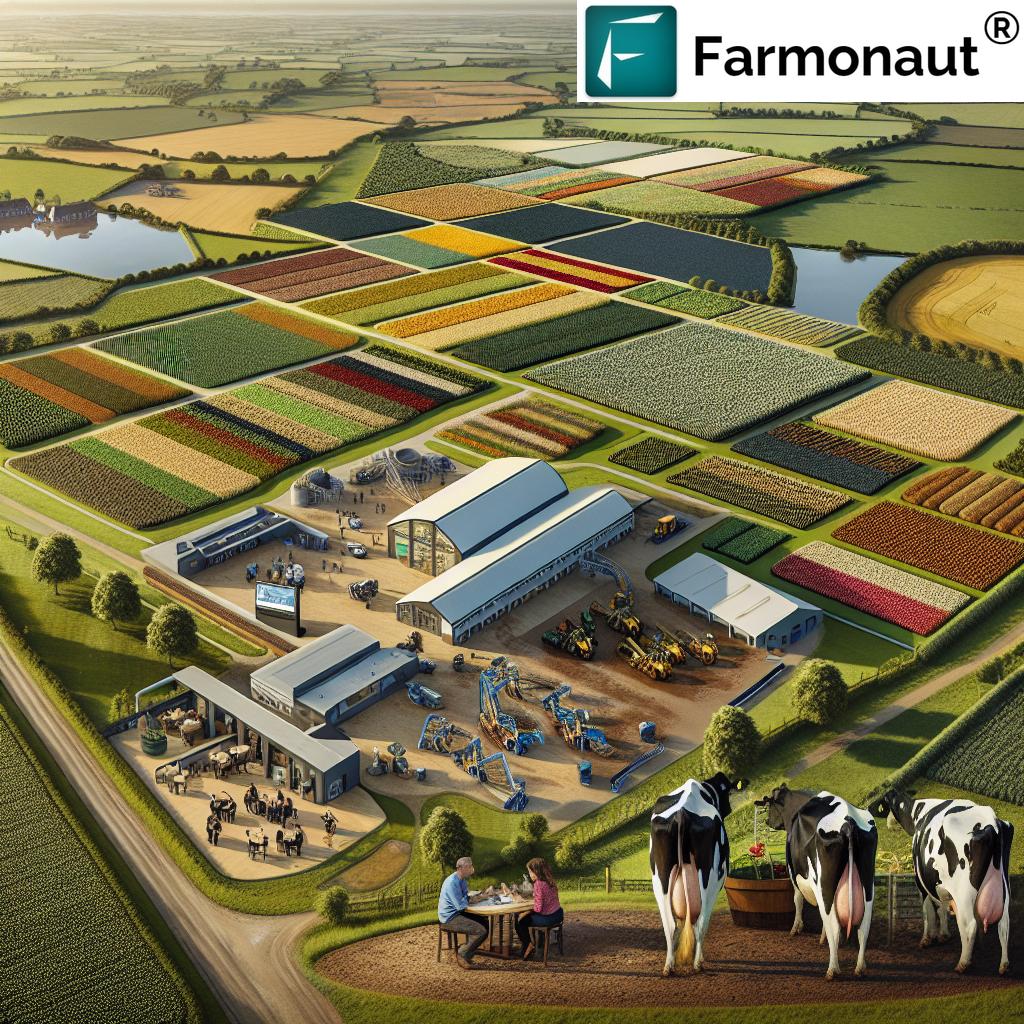Regenerative Farming in Wiltshire: How Sharing Experiences Builds a Stronger Agricultural Community

“Young farmers in the UK are 30% more likely to adopt regenerative farming practices compared to older generations.”
Welcome to our exploration of regenerative farming in Wiltshire and how the power of shared experiences is transforming our agricultural landscape. As we delve into this topic, we’ll uncover how farmers across England, Scotland, and Wales are embracing sustainable farming methods and building resilient communities through collaboration and innovation.
The Rise of Regenerative Agriculture in Wiltshire
Wiltshire, with its rolling hills and fertile plains, has long been a cornerstone of British agriculture. Today, it’s at the forefront of a farming revolution. Regenerative agriculture practices are taking root, quite literally, in the soil of this historic county. But what exactly is regenerative farming, and why is it gaining such momentum?
Regenerative agriculture is a holistic approach to farming that focuses on improving soil health, enhancing biodiversity, and increasing the resilience of the entire farm ecosystem. It’s not just about sustaining what we have; it’s about regenerating and improving our agricultural lands for future generations.
Key Principles of Regenerative Farming
- Minimizing soil disturbance
- Maximizing crop diversity
- Keeping soil covered
- Maintaining living roots in the soil
- Integrating livestock
These principles are being adopted by farms across Wiltshire, from small family-run operations to large arable farms. The results? Healthier soils, increased biodiversity, and more resilient crops that can better withstand the challenges of climate change.
The Power of Shared Experiences
One of the most remarkable aspects of the regenerative farming movement in Wiltshire is the spirit of collaboration that has emerged. Farmers, who have traditionally been known for their independent nature, are coming together to share knowledge, experiences, and even resources.
Young farmers networks are playing a crucial role in this knowledge exchange. These networks provide platforms for farmers to connect, learn from each other, and discuss the challenges and successes they’ve encountered in implementing regenerative practices.
Let’s take a closer look at how this sharing of experiences is shaping the agricultural community in Wiltshire and beyond.
Case Study: The Wiltshire Regenerative Farming Group
The Wiltshire Regenerative Farming Group, a grassroots organization founded by local farmers, exemplifies the power of community in advancing sustainable agriculture. This group organizes regular farm walks, workshops, and discussion forums where farmers can learn from each other’s successes and challenges.
John, a dairy farmer from near Salisbury, shares his experience: “Being part of this group has completely transformed my approach to farming. I’ve learned so much from my peers about integrating livestock into my crop rotation and managing soil health. It’s not just about the practices; it’s about having a support network that understands what you’re trying to achieve.”
Mixed Farming Techniques: A Return to Diversity
One of the key principles of regenerative agriculture that’s gaining traction in Wiltshire is the return to mixed farming techniques. This approach combines crop production with livestock rearing, creating a more diverse and resilient farm ecosystem.
Benefits of Mixed Farming
- Improved soil health through natural fertilization
- Enhanced biodiversity
- Reduced reliance on chemical inputs
- Diversified income streams for farmers
Sarah, an arable farmer who recently introduced sheep to her farm, explains: “Integrating livestock has been a game-changer. The sheep graze on cover crops, which helps build soil organic matter, and their manure provides natural fertilization. It’s reduced my input costs and improved the overall health of my land.”
This shift towards mixed farming is not just happening in Wiltshire. Farmers across England, Scotland, and Wales are rediscovering the benefits of diversification. It’s a prime example of how sharing experiences and knowledge can lead to widespread adoption of sustainable practices.
Innovative Farming Solutions: Technology Meets Tradition
While regenerative farming often emphasizes traditional practices, it doesn’t mean turning our backs on technology. In fact, innovative farming solutions are playing a crucial role in the success of regenerative agriculture in Wiltshire and beyond.
Farmonaut, a pioneering agricultural technology company, is at the forefront of this integration of technology and sustainable farming. Through its satellite-based farm management solutions, Farmonaut is making precision agriculture accessible to farmers of all scales.
How Technology Supports Regenerative Farming
- Real-time crop health monitoring
- AI-driven advisory systems for precision farming
- Blockchain-based traceability for supply chain transparency
- Resource management tools for efficient use of water and inputs
These technological solutions are helping farmers in Wiltshire and across the UK to implement regenerative practices more effectively. By providing data-driven insights, they enable farmers to make informed decisions about crop management, resource allocation, and sustainable practices.
“Collaborative farming networks have increased crop yields by up to 25% in some regions of England and Wales.”
Overcoming Challenges Through Community Support
Transitioning to regenerative farming practices isn’t without its challenges. Farmers in Wiltshire and across the UK face various obstacles, from initial yield dips to the need for new skills and knowledge. However, the strength of the agricultural community is proving to be a powerful asset in overcoming these hurdles.
Common Challenges in Adopting Regenerative Practices
- Initial investment in new equipment or infrastructure
- Learning curve for new farming techniques
- Market uncertainties for regeneratively produced goods
- Balancing short-term profitability with long-term sustainability
The agricultural community in Wiltshire is addressing these challenges head-on through various collaborative initiatives:
1. Equipment Sharing Programs
Farmers are pooling resources to purchase specialized equipment needed for regenerative practices, such as no-till drills or cover crop seeders. This not only reduces the financial burden on individual farmers but also fosters a sense of community ownership.
2. Mentorship Programs
Experienced regenerative farmers are partnering with those new to the practices, offering guidance and support. This knowledge transfer is crucial in helping farmers navigate the learning curve associated with new farming methods.
3. Cooperative Marketing Initiatives
To address market uncertainties, farmers are forming cooperatives to market their regeneratively produced goods. This collective approach provides greater bargaining power and helps create a dedicated market for sustainable products.
Explore Farmonaut’s API for advanced agricultural insights
The Role of Young Farmers in Driving Change
Young farmers are emerging as key drivers of the regenerative agriculture movement in Wiltshire and across the UK. Their enthusiasm for sustainable practices, coupled with their openness to new technologies and ideas, is helping to accelerate the adoption of regenerative farming methods.
How Young Farmers are Leading the Charge
- Embracing digital tools and precision agriculture technologies
- Actively participating in knowledge-sharing networks
- Experimenting with innovative crop rotations and cover crop mixes
- Advocating for policy changes to support sustainable farming
Emma, a young farmer who recently took over her family’s farm in Wiltshire, shares her perspective: “For my generation, sustainability isn’t just a buzzword – it’s a necessity. We’re looking at farming not just as a business, but as a way to be stewards of the land. The support from the farming community, especially other young farmers, has been incredible in helping us transition to more regenerative practices.”
The Wider Impact: From Farm to Table
The regenerative farming movement in Wiltshire isn’t just transforming agriculture; it’s having a ripple effect throughout the food system. Consumers are becoming more aware of the impact of their food choices, and there’s a growing demand for products that are not only healthy but also environmentally sustainable.
Connecting Farmers and Consumers
Initiatives like farm-to-table programs, farmers’ markets, and community-supported agriculture (CSA) schemes are flourishing in Wiltshire. These direct connections between farmers and consumers are creating a more transparent and resilient local food system.
Local restaurants and food businesses are also getting on board, showcasing regeneratively produced ingredients and educating their customers about the benefits of sustainable farming practices.
Looking to the Future: Scaling Up Regenerative Farming
As the success stories from Wiltshire and other regions demonstrate, regenerative farming has the potential to transform agriculture on a larger scale. But how can we ensure that these practices are adopted more widely across England, Scotland, and Wales?
Key Strategies for Scaling Up
- Continued investment in research and development
- Policy support for farmers transitioning to regenerative practices
- Expansion of farmer-to-farmer knowledge sharing networks
- Integration of regenerative principles into agricultural education
- Development of markets for regeneratively produced goods
The role of technology in this scaling-up process cannot be overstated. Platforms like Farmonaut are playing a crucial role in making precision agriculture and data-driven decision-making accessible to farmers of all scales.
Access Farmonaut’s API Developer Docs for integration possibilities

Regenerative Farming Practices Adoption in UK Regions
| Practice | England | Scotland | Wales | Community Impact | Challenges |
|---|---|---|---|---|---|
| Cover Cropping | 45% | 35% | 40% | Improved soil health, reduced erosion | Seed costs, management timing |
| No-Till Farming | 30% | 25% | 28% | Increased soil organic matter, reduced fuel costs | Initial equipment investment, weed management |
| Crop Rotation | 65% | 60% | 62% | Pest reduction, improved nutrient cycling | Market demand for diverse crops, planning complexity |
| Integrated Livestock Management | 40% | 50% | 55% | Enhanced biodiversity, natural fertilization | Infrastructure needs, additional labor requirements |
Conclusion: Building a Resilient Agricultural Future
The story of regenerative farming in Wiltshire is a testament to the power of community, innovation, and shared knowledge. As farmers across England, Scotland, and Wales continue to embrace sustainable practices and collaborate with their peers, we’re witnessing the birth of a more resilient and sustainable agricultural future.
The challenges are significant, but so are the opportunities. By continuing to share experiences, leverage technology, and support one another, the agricultural community is not just adapting to change – it’s leading it.
As we look to the future, it’s clear that the success of regenerative farming will depend on the continued strength of our agricultural communities. Whether you’re a farmer in Wiltshire, a consumer interested in sustainable food systems, or a technology provider like Farmonaut, we all have a role to play in building a more sustainable and resilient agricultural future.
FAQs
- What is regenerative farming?
Regenerative farming is an approach to agriculture that focuses on improving soil health, enhancing biodiversity, and increasing the resilience of the entire farm ecosystem. It aims to regenerate and improve agricultural lands for future generations. - How are young farmers contributing to regenerative agriculture?
Young farmers are driving change by embracing new technologies, actively participating in knowledge-sharing networks, experimenting with innovative practices, and advocating for policy changes to support sustainable farming. - What role does technology play in regenerative farming?
Technology, such as Farmonaut’s satellite-based farm management solutions, plays a crucial role by providing real-time crop health monitoring, AI-driven advisory systems, and resource management tools that help farmers implement regenerative practices more effectively. - How can consumers support regenerative farming?
Consumers can support regenerative farming by purchasing products from farms that use sustainable practices, participating in community-supported agriculture (CSA) schemes, and educating themselves about the benefits of regenerative agriculture. - What are some challenges in adopting regenerative farming practices?
Challenges include initial investment in new equipment, learning new farming techniques, market uncertainties for regeneratively produced goods, and balancing short-term profitability with long-term sustainability.




















